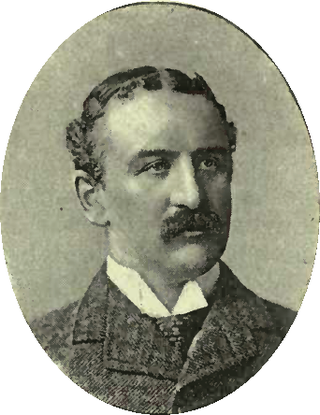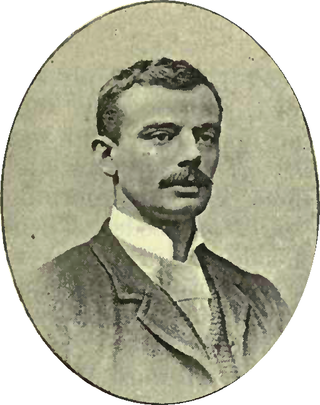Related Research Articles

George Louis Palmella Busson du Maurier was a Franco-British cartoonist and writer known for work in Punch and a Gothic novel Trilby, featuring the character Svengali. His son was the actor Sir Gerald du Maurier. The writers Angela du Maurier and Daphne du Maurier and the artist Jeanne du Maurier were all granddaughters of George. He was also father of Sylvia Llewelyn Davies and grandfather of the five boys who inspired J. M. Barrie's Peter Pan.
Welburn is a village and civil parish in North Yorkshire, in England, 2 miles south-west of Kirkbymoorside and about 24 miles from York. The population of the parish was estimated at 60 in 2012. As the population of the civil parish was less than 100 it was not separately counted in the 2011 census and was included with the civil parish of Wombleton.

Deborah Alcock was a late-Victorian author of historical fiction focused on religious, evangelical themes.
Reginald Halsey Birkett was an English footballer who played for Clapham Rovers, as well as the England national side. He also played international rugby union for England in 1871, in the first international rugby match. In this match he scored England's first try.
Edward O'Donovan Crean was an English rugby union player who was part of the first official British & Irish Lions team that toured South Africa in 1910. He is one of a small number of Lions players to have never played for their national side.
Sir George Vandeleur Fiddes, was the British Permanent Under-Secretary of State for the Colonies.

Murray Marshall was a rugby union international who represented England from 1873 to 1878. He also captained his country.

Fernand "Fred" Bonsor (1862-1932) was a rugby union international who represented England from 1886 to 1889, he also captained his country. At club level he played for Bradford FC, and Skipton RFC.

Dawson Turner was a rugby union international who represented England from 1871 to 1875.

Henry John Cecil Turner was a rugby union international who represented England in 1871 in the first international match.
Francis Loraine Petre was a British civil servant in India and a military historian upon his retirement. He wrote a two-volume regimental history of the Norfolk Regiment, but is best known for his works on the Napoleonic Wars. The grandson of the 11th Baron Petre, he was educated at Oscott College and joined the Bar in 1880. He took the civil service exam and subsequently joined the Indian Civil Service. He retired as Commissioner of Allahabad in 1900.
Sir Edward John Harding was a prominent British civil servant and diplomat and former High Commissioner to South Africa.
Percival Wilkinson was a rugby union international who represented England in 1872 against Scotland in his only appearance for the national side.
Andrew Bulteel (1850–1888) was a rugby union international who represented England in 1875.

John Edmund Bentley was an English sportsman who played in the first international rugby football match in 1871, representing England as a halfback.

St Mary the Virgin Church is located in Latton, Harlow, Essex, England. It is an Anglican church and is liberal catholic in tradition. The church building is Grade I listed.
Ernest William Jones was a Welsh trans-European steamship agent, and a first class cricketer.
Herbert Brooks, was an English rugby union footballer who played in the 1880s, who played in Scotland for Edinburgh University RFC, and was selected to play at a representative level for the British Isles on the 1888 British Lions tour to New Zealand and Australia, the first tour by a team representing the British Isles.
James Genth (1849–1926) was a rugby union international who represented England from 1874 to 1875.
Charles Clark was a rugby union international who represented England in 1875. Making his debut at just 19 years old, he scored the first international try in Ireland.
References
- ↑ E F Walker Profile on scrum.com
- 1 2 1911 England Census, RG14PN39 RG78PN1 RD1 SD1 ED39 SN311
- 1 2 1891 England Census, Class: RG12; Piece: 461; Folio 40; Page 13; GSU roll: 6095571, Census Returns of England and Wales, 1891. Kew, Surrey, England: The National Archives of the UK (TNA): Public Record Office (PRO), 1891.
- 1 2 3 4 5 6 7 8 9 1881 England Census, Class: RG11; Piece: 669; Folio: 38; Page: 15; GSU roll: 1341155.
- ↑ Proceedings - Institution of Mechanical Engineers, Volume 47, Parts 3–4 (Institution of Mechanical Engineers (Great Britain)), 1894 - Technology & Engineering p166
- ↑ 1891 England Census, Class: RG12; Piece: 772; Folio 5; Page 4; GSU roll: 6095882., Census Returns of England and Wales, 1891. Kew, Surrey, England: The National Archives of the UK (TNA): Public Record Office (PRO), 1891.
- 1 2 3 FOOTBALL. NOTES BY FULL BACK. Otago Witness, Putanga 2590, 4 Whiringa-ā-rangi 1903, Page 58 - containing a profile of the 1903 British touring side
- ↑ 1901 England Census, Class: RG13; Piece: 438; Folio: 84; Page: 5., Census Returns of England and Wales, 1901. Kew, Surrey, England
- 1 2 The Bystander: an illustrated weekly, devoted to travel, literature, art, the drama, progress, locomotion, Volume 10, p197, 1906
- ↑ THE RULES OF RUGBY. Otago Witness, Issue 2861, 13 January 1909, Page 63